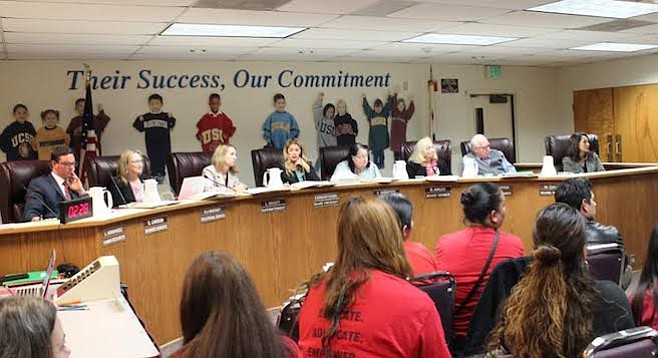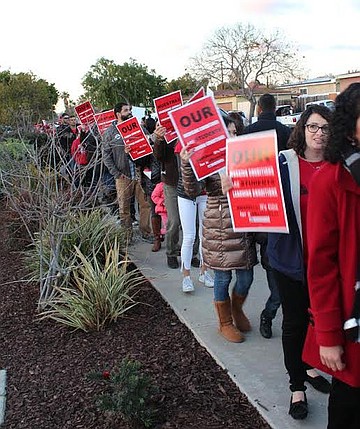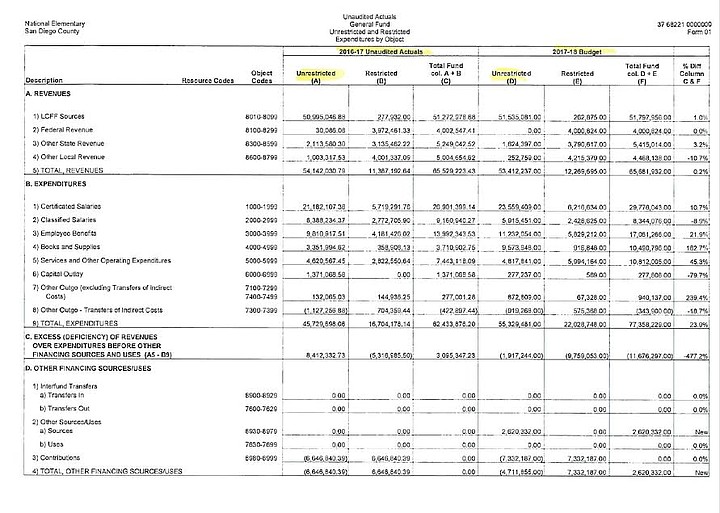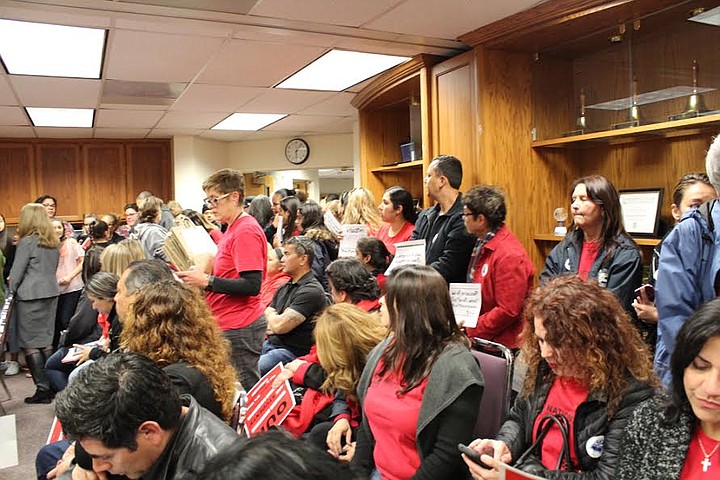 Facebook
Facebook
 X
X
 Instagram
Instagram
 TikTok
TikTok
 Youtube
Youtube

“Your educators are falling apart,” Christina Benson, president of the National City Education Teachers Association, told district boardmembers this week. The union continues to protest an impasse in negotiations between the district and teachers.

On Wednesday, February 28, over 250 teachers, parents, and students rallied outside the National School District offices chanting and holding signs along the sidewalk. Once the board meeting began, they filled up seats, aisles, and hallways.
Teachers maintain that there has been a budget surplus for the past four years, but the district refuses to spend the money even though teachers have no curriculum for their students.
At the board meeting, assistant superintendent of business services Christopher Carson gave a presentation on the state of the economy in which he presented a different perspective: “There’s some economic factors that are potentially pointing to an economic downturn,” he said.
One example, he said, was that gross domestic product of the United States has been dropping, which indicates a slowing of the economy. Other factors included the possible renegotiation of North American Free Trade Agreement and the new tax plan. For the National School District, however, Carson explained that new Local Control and Accountability Plan (LCAP) funding means revenues are projected to increase by about $3 million within the next year.

“What you’ll see is an increase in our total revenues,” Carson admitted.
During the protest rally, teachers argued that the state only requires districts to keep 2 percent in reserves, but Carson disputed the claim in his presentation. “When looking at the 2015–’16 year, we had 17 percent reserve. The statewide average for an elementary-school district in 2015–’16, which is the last year the data is available, was 21.54 percent. So, the district is 4½ percent lower than the state average.”
In addition, Carson disputed the claim made in a Reader article that stated the district had $10.5 million in books and supplies. Carson said, “When looking at our adopted budget in 2016–2017, it was actually $5 million.”
Curiously, the San Diego County Office of Education provided a copy of the district’s budget that showed only $3.7 million had been reserved for books and supplies in the 2016–2017 school year. Meanwhile, the projected budget for books and supplies in 2017–2018 had ballooned to $10.49 million — a 182.7 percent increase in anticipated spending.

Carson explained to boardmembers that caution in spending was needed because “when thinking about the ending balance, you need to think about it as your bank account. If I ask you for a dollar out of your bank account today, can you then spend that dollar tomorrow as well? Once you’ve spent it, it’s gone.”
A public records request showed that Carson and fellow assistant superintendent Paula Jameson-Whitney receive salaries of $157,330 as well as a mileage stipend totaling $3300 annually. Superintendent Leighangela Brady, who lives in Clairemont and was hired in October 2016, receives a salary of $200,349.
Furthermore, purchasing-card expenses available at the district website showed that when boardmembers Maria Dalla, Maria Betancourt-Castaneda, and Barbara Avalos attended a National Association of Latino Elected Officials Conference in Dallas, Texas, they stayed at the Sheraton Hotel for a total of $917.47 per room.

In December 2017, Brady reported paying over $5700 for airfare so boardmembers could attend a Department of Education board meeting in Sacramento as well as for meals at Pearl on the River ($398.15), the Tin Fish ($109.02), the Blond Burro ($142.03), and Seasons 52 ($368.08).
In September 2017, Carson paid $1020 for a November CBO Symposium in Anaheim, plus $212.97 in airfare for an Inclusion Collaborative Conference in San Jose. Carson also spent district money on many office supplies from “floor mat for Ginny, wipes and Lysol” to binders, scissors, and Sharpie pens. His purchasing-card expenses showed that he spent $423.14 in June 2017, $177.25 in August 2017, $312.09 in September 2017, and $146.62 in December 2017 — all on office supplies.
Meanwhile, teachers said repeatedly that they had to pay for curriculum materials out of their own pockets. During public comments at the board meeting, one teacher explained, “In first grade we have not had phonic curriculum to teach our students how to read. So, we used to have the green workbooks and then all of a sudden they said, ‘No they’re not aligned with Common Core.’ Okay, so what did we do? We bought curriculum out of our pockets or created worksheets.”
Another teacher said, “I just wanted to let the boardmembers know that my students don’t have science books that are aligned with [Next Generation Science Standards]… The NGSS standards have been around for five years now. I don’t have a book to teach science.”
Countless public speakers — both at the podium and in interviews — described a district in crisis: low teacher wages, promises of raises that never came, a dramatic increase in teacher workload, a lack of counselors, no designated homeless liaison, and volunteer parents paying for student supplies.
The total population of National City is about 60,000 residents. The median household income is $41,437, compared to the $67,739 median for all of California. National City also has 12,624 (21.7 percent) residents living in poverty.
The National School District has about 5900 students at ten schools (K–6), a charter and a pre-school. According to the California Department of Education, 57.3 percent are English learners. In addition, state figures for 2017 show that 33.11 percent of students did not meet the English language arts standards and 34.67 percent did not meet the mathematics standards. Furthermore, San Diego County’s annual homeless education data for 2015–2016 revealed that 991 students in the National School District are classified as homeless.
In one interview, Molly Sterner, a third-grade teacher at Rancho de la Nación School, said, “These kids are coming with so many challenges. We need support services for our families. We need counseling and therapy for our kids. These kids are dealing with immigration issues. Some of them are living in their cars. I have a kid who is falling apart because his dad was picked up by ICE in June. We’re not identifying and supporting those kids.”


“Your educators are falling apart,” Christina Benson, president of the National City Education Teachers Association, told district boardmembers this week. The union continues to protest an impasse in negotiations between the district and teachers.

On Wednesday, February 28, over 250 teachers, parents, and students rallied outside the National School District offices chanting and holding signs along the sidewalk. Once the board meeting began, they filled up seats, aisles, and hallways.
Teachers maintain that there has been a budget surplus for the past four years, but the district refuses to spend the money even though teachers have no curriculum for their students.
At the board meeting, assistant superintendent of business services Christopher Carson gave a presentation on the state of the economy in which he presented a different perspective: “There’s some economic factors that are potentially pointing to an economic downturn,” he said.
One example, he said, was that gross domestic product of the United States has been dropping, which indicates a slowing of the economy. Other factors included the possible renegotiation of North American Free Trade Agreement and the new tax plan. For the National School District, however, Carson explained that new Local Control and Accountability Plan (LCAP) funding means revenues are projected to increase by about $3 million within the next year.

“What you’ll see is an increase in our total revenues,” Carson admitted.
During the protest rally, teachers argued that the state only requires districts to keep 2 percent in reserves, but Carson disputed the claim in his presentation. “When looking at the 2015–’16 year, we had 17 percent reserve. The statewide average for an elementary-school district in 2015–’16, which is the last year the data is available, was 21.54 percent. So, the district is 4½ percent lower than the state average.”
In addition, Carson disputed the claim made in a Reader article that stated the district had $10.5 million in books and supplies. Carson said, “When looking at our adopted budget in 2016–2017, it was actually $5 million.”
Curiously, the San Diego County Office of Education provided a copy of the district’s budget that showed only $3.7 million had been reserved for books and supplies in the 2016–2017 school year. Meanwhile, the projected budget for books and supplies in 2017–2018 had ballooned to $10.49 million — a 182.7 percent increase in anticipated spending.

Carson explained to boardmembers that caution in spending was needed because “when thinking about the ending balance, you need to think about it as your bank account. If I ask you for a dollar out of your bank account today, can you then spend that dollar tomorrow as well? Once you’ve spent it, it’s gone.”
A public records request showed that Carson and fellow assistant superintendent Paula Jameson-Whitney receive salaries of $157,330 as well as a mileage stipend totaling $3300 annually. Superintendent Leighangela Brady, who lives in Clairemont and was hired in October 2016, receives a salary of $200,349.
Furthermore, purchasing-card expenses available at the district website showed that when boardmembers Maria Dalla, Maria Betancourt-Castaneda, and Barbara Avalos attended a National Association of Latino Elected Officials Conference in Dallas, Texas, they stayed at the Sheraton Hotel for a total of $917.47 per room.

In December 2017, Brady reported paying over $5700 for airfare so boardmembers could attend a Department of Education board meeting in Sacramento as well as for meals at Pearl on the River ($398.15), the Tin Fish ($109.02), the Blond Burro ($142.03), and Seasons 52 ($368.08).
In September 2017, Carson paid $1020 for a November CBO Symposium in Anaheim, plus $212.97 in airfare for an Inclusion Collaborative Conference in San Jose. Carson also spent district money on many office supplies from “floor mat for Ginny, wipes and Lysol” to binders, scissors, and Sharpie pens. His purchasing-card expenses showed that he spent $423.14 in June 2017, $177.25 in August 2017, $312.09 in September 2017, and $146.62 in December 2017 — all on office supplies.
Meanwhile, teachers said repeatedly that they had to pay for curriculum materials out of their own pockets. During public comments at the board meeting, one teacher explained, “In first grade we have not had phonic curriculum to teach our students how to read. So, we used to have the green workbooks and then all of a sudden they said, ‘No they’re not aligned with Common Core.’ Okay, so what did we do? We bought curriculum out of our pockets or created worksheets.”
Another teacher said, “I just wanted to let the boardmembers know that my students don’t have science books that are aligned with [Next Generation Science Standards]… The NGSS standards have been around for five years now. I don’t have a book to teach science.”
Countless public speakers — both at the podium and in interviews — described a district in crisis: low teacher wages, promises of raises that never came, a dramatic increase in teacher workload, a lack of counselors, no designated homeless liaison, and volunteer parents paying for student supplies.
The total population of National City is about 60,000 residents. The median household income is $41,437, compared to the $67,739 median for all of California. National City also has 12,624 (21.7 percent) residents living in poverty.
The National School District has about 5900 students at ten schools (K–6), a charter and a pre-school. According to the California Department of Education, 57.3 percent are English learners. In addition, state figures for 2017 show that 33.11 percent of students did not meet the English language arts standards and 34.67 percent did not meet the mathematics standards. Furthermore, San Diego County’s annual homeless education data for 2015–2016 revealed that 991 students in the National School District are classified as homeless.
In one interview, Molly Sterner, a third-grade teacher at Rancho de la Nación School, said, “These kids are coming with so many challenges. We need support services for our families. We need counseling and therapy for our kids. These kids are dealing with immigration issues. Some of them are living in their cars. I have a kid who is falling apart because his dad was picked up by ICE in June. We’re not identifying and supporting those kids.”
Comments